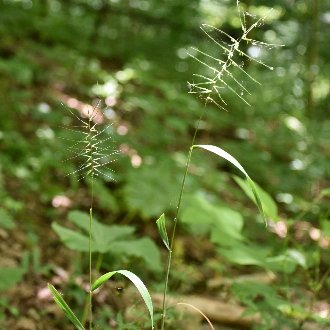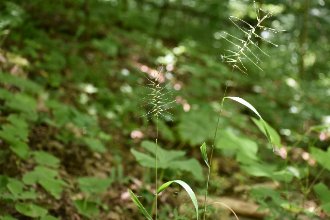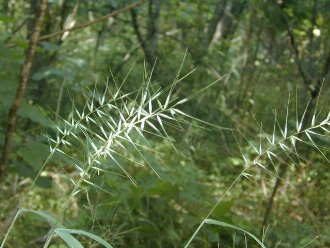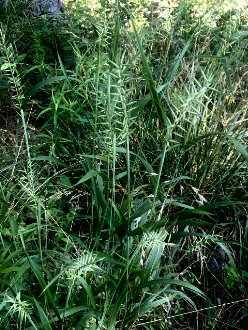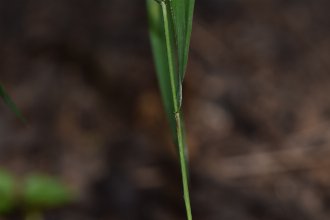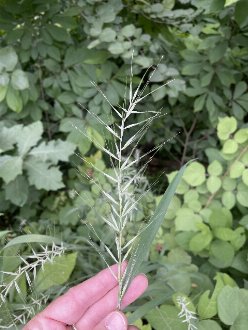Eastern Bottlebrush Grass (Elymus hystrix L.)
Also known as eastern bottle brush grass; also classified as Hystrix patula.
↑Summary
A large perennial, cool-season grass native to forests of eastern North America, named for the distinct bottlebrush shape of its spike.
↑Range - Expand
| Legend | Color |
| Native | |
| Native or Not Present | |
| Introduced or Not Present |
This tentative map is based on our own research. It may have limited data on Canada and/or Mexico, and there is some subjectivity in our assignment of plants as introduced vs. expanded. Read more in this blog post.
Although this plant occurs somewhere in each of these regions, it may only occur in a small part of some or all of them.
↑Description & Identification
This species is distinctive among the Elymus species and is usually easy to identify when spikes are present. It is most frequently confused with E. villosus.
↑Similar Plants
↑Habitat
Found in woodlands and woodland clearings, including rocky upland woods, especially those over mafic or calcareous rocks, gaps, edges, or disturbed sites in rich mesic forests, and on well-drained sites in floodplains. Found in deciduous forests throughout, and in mixed and coniferous forests in the north of its range but absent from pine forests in the south of its range. Less common than other Elymus species in anthropogenic habitats, but frequently found along woodland paths, and also sometimes found in suburban parks and anthropogenic woodland edges, especially on sites that are not too heavily degraded.
Prefers loamy soil rich in decaying organic matter, but can tolerate rocky soils, heavy clay soils if not on too poorly-drained a site, and sandy soils if they are sufficiently rich in calcium and/or magnesium. Absent from more acidic soils. Found in a range of moisture conditions from moist to dry; moisture preferences vary regionally and by soil type. Prefers partial sun to light shade, but can tolerate heavier shade than most other Elymus species.
Can be found in mature oak-hickory forests and can persist indefinitely on sites where slightly open conditions are stable, but on richer sites dominated by more shade-tolerant trees, it is usually limited to temporary openings created by disturbance. On such sites, favors small-scale disturbances that leave much of the forest intact, so this plant can have the partial shade and rich leaf litter it requires.
↑Life Cycle
Elymus hystrix is a long-lived, cool-season, perennial bunchgrass.
Seeds can germinate either in spring or fall, with seeds distributed earlier being more likely to germinate immediately. Foliage growth and photosynthetic activity is concentrated in moderate temperatures of spring and fall. Fall growth is concentrated near the ground, and this basal foliage is semievergreen to evergreen in the mildest parts of its range. Spring growth is more upright and culminates in flowering and seed production. This plant grows taller (to 5 feet) with support from competing vegetation, and overall has a taller and more upright habit during the spring growing season than most Elymus species. Because its growth and photosynthesis is concentrated in the early part of the growing season, it is more competitive with ground-level vegetation than later-emerging plants of similar height.
Seed germination is high but seedling mortality is also high. Plants that survive their first year, however, are likely to live for years.
Plants may flower in their first year, if growing conditions are favorable. Many plants do not flower until their second year. Flowers are self-compatible, and isolated plants still produce seeds, but flowers are usually wind-pollinated. The foliage on the stem is usually still green at the time of blooming. On drier sites and in drier years, the leaves on the stem often wither by the time the seeds ripen, but they may stay green when and where there is sufficient moisture.
The timing of seed distribution is more variable in this species than in some Elymus species; although the seed matures early as in E. villosus, earlier than most Elymus species, and some may be shed immediately on maturity, unlike E. villosus, significant seed may remain on the stem well into winter. Due to the shape of the spikes, the seed is more sensitive to being brushed against by an animal, so random events may drive differences in timing of distribution from one spike to the next. The long awns allow the spikes to stick to clothing or animal fur for a short time and thus aid seed distribution.
This species invests most of its energy in vegetative growth and produces little seed relative to the extent of each plant. It does not spread very far vegetatively, instead each clump becoming more vigorous each year and sending up more stems. Established plants are highly competitive with ground-level herbaceous vegetation, and are often among some of the taller plants in the habitats where they occur.
The typical lifespan of this species is not known but, given its low investment in seed production, it is likely over 10 years and possibly much longer. A 2006 study (Mottl et al.) found transplanted plants had 60% survival at 7 years. Lifespan of individual plants is likely longer in more stable habitats where lighting conditions are the result of persistent conditions limiting the closure of the forest canopy, such as near rock outcroppings, and shorter in more transient habitats such as a gap in a richer forest opened by a disturbance.
Established plants can be killed by heavy shading from a closed canopy, prolonged flooding, or severe drought. Seedlings are more vulnerable and are more likely to succumb to competition from other herbaceous plants or shorter-term drought.
↑Faunal Associations
In spring, the foliage is attractive to mammalian herbivores, including livestock, but as the seeds develop it becomes less appealing because the sharp awns can irritate or damage tongues. Although deer do browse this plant it is fairly resistant to damage by deer and usually not much harmed by herbivory. The seeds are eaten by the white-footed mouse (Peromyscus leucopus), which aids seed dispersal by caching seeds in the fall and storing more than it can eat. Birds also eat the seeds, and use more robust colonies of the plant for cover.
This species is particularly valuable for supporting specialist insects. It is eaten by a number of lepidoptera larvae, including the northern pearly-eye (Lethe anthedon) butterfly, and by leaf-miner moths which specialize on Elymus species, including Elachista leucofrons, Elachista epimicta and Elachista praelineata, which may prefer this species, and Elachista orestella, which has only been recorded eating this species, and the lanceolate helcystogramma moth (Helcystogramma hystricella) which prefers this species but may also eat other grasses, and Asymmetrura graminivorella, which may have originally only eaten this species, but has also adapted to eat several introduced grasses including orchardgrass (Dactylis glomerata), Canada bluegrass (Poa compressa), and various ryegrass (Lolium) species. The shoots and roots are eaten by the the golden borer moth (Papaipema cerina).
The leaves are also mined by the larvae of the leaf beetle Chalepus walshii and the fly Cerodontha angulata.
The plant also supports the aphids Carolinaia howardii, which also eats true sedges (Carex sp.), and Carolinaia rhois, which alternates hosts between sumacs (Rhus sp.) in spring, and the seedheads of this and other cool-season grasses when they bloom in summer. It is also eaten by the leafhoppers Elymana acuma and Sorhoanus orientalis.
↑Control
Although this species is not yet reported as invasive anywhere, it has been introduced outside its native range in at least two regions: in New Mexico and Austria. It likely has some invasive potential.
In order to prevent this species becoming invasive, it is important to avoid planting it outside its native range or areas directly adjacent to its native range.
↑Uses
Bottlebrush grass is widely cultivated as an ornamental grass, where it is valued for the distinctive appearance of its inflorescence, its shade-tolerance, and its ability to thrive in a wide range of partly-shaded garden settings. It also is good at supporting insects, particularly lepidoptera, and can usually withstand significant deer browsing. Although it is sometimes slow to establish, in some garden settings it can be come aggressive in the long-run.
This species is also often used in savanna and woodland restoration projects, where it is relatively easy to either seed or transplant onto a site and tends to have a good survival rate on suitable sites.
↑Related Plants
There are numerous Elymus (or wild rye) species in North America. Most are native, but the introduced Elymus repens has a wide distribution and is typically considered an invasive species.
Quite a few native species overlap with E. hystrix in range. Some of the more widely-distributed species include E. canadensis, E. submuticus, E. trachycaulus, and E. virginicus.
This species sometimes occurs together with these grasses in the same habitats, and it hybridizes with them more readily than some other species do with each other. Hybrids with E. virginicus are named E. ×ebingeri.
↑Links & External Resources
• Elymus hystrix (Bottlebrush Grass) | Illinois Wildflowers (About This Site)
• Elymus hystrix (Eastern Bottlebrush Grass) | USDA PLANTS Database (About This Site)
• Elymus hystrix | Go Botany (About This Site)
• Elymus hystrix (Bottlebrush Grass) | Missouri Botanical Garden Plant Finder (About This Site)
• Elymus hystrix | Biota of North America Project (BONAP) (About This Site)
• Elymus hystrix | NatureServe Explorer (About This Site)
• Elymus hystrix | Flora of North America (About This Site)
• Elymus hystrix L. | Plants of the World Online (POWO) (About This Site)
• Elymus hystrix | Missouri Plants (About This Site)
• Eastern Bottlebrush Grass | Maryland Biodiversity Project (About This Site)
• Elymus hystrix L. var. hystrix (Bottlebrush Grass) | Digital Atlas of the Virginia Flora (About This Site)
• Elymus hystrix L. var. piedmontanus Poindexter & Weakley (Piedmont Bottlebrush Grass) | Digital Atlas of the Virginia Flora (About This Site)



